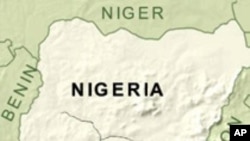Massive environmental degradation has been the subject of heightened
concern across southeast Nigeria as the region continues to be plagued
by an erosion crisis that has grown worse over the years.
Driving
around southeast Nigeria, examples of soil erosion at its worst are a
common sight. Deep gullies, washed away homes, bridges and roads are
hard to ignore. Anambra is easily the worst affected state in the
region. The state's environment commissioner Michael Egbebike speaks to
VOA.
"The nature of the soil we have in the state, climatic
conditions make Anambra one of the worst hit areas when it comes to
erosion," he said. "It is on record that we have more than 1,000
erosion sites in the state, more than 500 are active. I should call
this a major disaster in Anambra state, and that is what we are dealing
with here."
Residents say the 50-year-old problem has grown
worse because the authorities failed to make repairs when their
attention was drawn to it at the onset. Several other factors have
combined to amplify the severity of the erosion. According to
Environment Commissioner Egbebike, local residents have also
contributed to the problem.
"Some of the problem of erosion is
created by our people, by our attitude to waste disposal," he said.
"When we dump garbage in the drains that are built by government we
simply aggravate the problem of erosion. And this waste combined with
the force of the flood and trying to erode the soil and sometimes they
actually block the channel that has been created for flood dispersion
and the floods come back and actually destroy their homes, and at that
point they call on government."
Idiani, a small community in
Anambra state, has seen enormous damage to its homes, crops and
infrastructure. The villagers also risk being swept to their death by
flood water during the rainy season. Village head Harrison Okoye
describes the devastating effects of gully erosion.
"My village
Town Hall built with a huge sum of money has been swallowed," he said.
"And a lot of economic trees gone. The Anglican Church is on the verge
of going. One man from Egboku after going to wedding, seeing the volume
of water, he stopped his car to see the depth so that he will know how
to pass. As soon as he stepped down, he was swept off to the stream
down there and that was the end of the man."
Environmentalists
warn once it takes hold, it becomes a losing battle to reverse
landslides and degradation. In neighboring Abatete residents, including
Efobi Okeke, are not giving up on their homes and community.
"Usually
you cannot fold your arms and get your house being carried away into
the gullies," he said. "So people are making efforts on their own but
the situation is such that individuals cannot handle alone."
A
recent geological study of the environmental degradation in Anambra
reported it will cost about $2 billion to address the gully erosion
problem in the area. Environment Commissioner Ebgebike says funding is
critical and appeals for international help to deal with the situation.
"We
have a shortage of resources," he said. "The state is struggling
because the monies spent on this erosion problem are huge sums of
money. So we will of course need a lot of help from the international
community and the federal government. Alone it would be a Herculean
task for Anambra state."
In the meantime, Abatete and Idiani
residents, like others across the southeast, are clinging to the last
of their homes, even as erosion continues its unstoppable conquest
across the region.
News
Erosion Wreaks Havoc in Southeastern Nigeria
update

<!-- IMAGE -->




